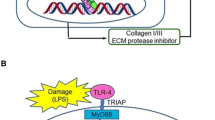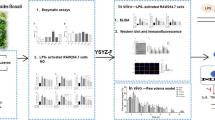Abstract
Seseli is a herb widely used for its anti-inflammation, anti-flatulence and various other healing properties. In the present study, we investigated the effects of samidin on the production of pro-inflammatory mediators in lipopolysaccharide (LPS)-stimulated RAW 264.7 cells. The results demonstrated that samidin significantly inhibited the production of nitric oxide, as well as the gene expression levels of inducible nitric oxide synthase and cyclooxygenase-2. The results from an electrophoretic mobility shift assay illustrated that samidin significantly suppressed NF-κB and AP-1 DNA-binding affinity. In addition, both the NF-κB subunit p65 and the AP-1-related c-jun were markedly inhibited by samidin. The time course experiment demonstrated that samidin showed significant inhibitory effect on p38 and JNK activation. Furthermore, tumor necrosis factor-α mRNA level were remarkably down-regulated by samidin in LPS-stimulated macrophages based on quantitative-real-time polymerase chain reaction. Our results suggested that samidin has a potential to be developed as a therapeutic agent for various inflammatory diseases.







Similar content being viewed by others
References
Chao, L.K., P.C. Liao, C.L. Ho, E.I. Wang, C.C. Chuang, H.W. Chiu, L.B. Hung, and K.F. Hua. 2010. Anti-inflammatory bioactivities of honokiol through inhibition of protein kinase C, mitogen-activated protein kinase, and the NF-κB pathway to reduce LPS-induced TNF-α and NO expression. Journal of Agricultural and Food Chemistry 58: 3472–3478.
Choi, R.J., T.M. Ngoc, K. Bae, H.J. Cho, D.D. Kim, J. Chun, S. Khan, and Y.S. Kim. 2013. Anti-inflammatory properties of anthraquinones and their relationship with the regulation of P-glycoprotein function and expression. European Journal of Pharmaceutical Sciences 48: 272–281.
Eferl, R., and E.F. Wagner. 2003. AP-1: A double-edged sword in tumorigenesis. Nature Review Cancer 3: 859–868.
Hruby, Z., and K.F. Beck. 1997. Cytotoxic effect of autocrine and macrophage-derived nitric oxide on cultured rat mesangial cells. Clinical and Experimental Immunology 107: 76–82.
Kaya, A., B. Demirci, and K.H.C. Base. 2003. The essential oil of Seseli tortuosum L. growing in Turkey. Flavour and Fragrance Journal 18: 159–161.
Khan, S., R.J. Choi, O. Shehzad, H.P. Kim, M.N. Islam, J.S. Choi, and Y.S. Kim. 2013. Molecular mechanism of capillarisin-mediated inhibition of MyD88/TIRAP inflammatory signaling in in vitro and in vivo experimental models. Journal of Ethnopharmacology 145: 626–637.
Khan, S., O. Shehzad, H.G. Jin, E.R. Woo, S.S. Kang, S.W. Baek, J. Kim, and Y.S. Kim. 2012. Anti-inflammatory mechanism of 15,16-epoxy-3α-hydroxylabda-8,13(16),14-trien-7-one via inhibition of LPS-induced multicellular signaling pathways. Journal of Natural Products 75: 67–71.
Khan, S., E.M. Shin, R.J. Choi, Y.H. Jung, J. Kim, A. Tosun, and Y.S. Kim. 2011. Suppression of LPS-induced inflammatory and NF-κB responses by anomalin in RAW 264.7 macrophages. Journal of Cellular Biochemistry 112: 2179–2188.
Kiemer, A.K., C. Muller, and A.M. Vollmar. 2002. Inhibition of LPS-induced nitric oxide and TNF-α production by α-lipoic acid in rat Kupffer cells and in RAW 264.7 murine macrophages. Immunology and Cell Biology 80: 550–557.
Kupeli, E., A. Tosun, and E. Yesilada. 2006. Anti-inflammatory and antinociceptive activities of Seseli L. species (Apiaceae) growing in Turkey. Journal of Ethnopharmacology 104: 310–314.
Makarov, S.S. 2000. NF-κB as a therapeutic target in chronic inflammation: Recent advances. Molecular Medicine Today 6: 441–448.
Nagy, G., J.M. Clark, E.I. Buzas, C.L. Gorman, and A.P. Cope. 2007. Nitric oxide, chronic inflammation and autoimmunity. Immunology Letters 111: 1–5.
Pope, R.M., and J. Tschopp. 2007. The role of interleukin-1 and the inflammasome in gout: Implications for therapy. Arthritis and Rheumatism 56: 3183–3188.
Senthil Kumar, K.J., H.W. Hsieh, and S.Y. Wang. 2010. Anti-inflammatory effect of lucidone in mice via inhibition of NF-κB/MAP kinase pathway. International Immunopharmacology 10: 385–392.
Shehzad, O., S. Khan, I.J. Ha, Y. Park, A. Tosun, and Y.S. Kim. 2013. Application of stepwise gradients in counter-current chromatography: A rapid and economical strategy for the one-step separation of eight coumarins from Seseli resinosum. Journal of Chromatography A 1310: 66–73.
Tosun, A., M. Baba, O. Bahadir, and T. Okuyama. 2006. Coumarins isolated from the roots of Seseli resinosum in Turkey. Pharmaceutical Biology 44: 528–533.
Tripathi, P., L. Kashyap, and V. Singh. 2007. The role of nitric oxide in inflammatory reactions. FEMS Immunology and Medical Microbiology 51: 443–452.
Wadleigh, D.J., S.T. Reddy, E. Kopp, S. Ghosh, and H.R. Herschman. 2000. Transcriptional activation of the cyclooxygenase-2 gene in endotoxin-treated RAW 264.7 macrophages. Journal of Biological Chemistry 275: 6259–6266.
Wagner, E.F., and A.R. Nebreda. 2009. Signal integration by JNK and p38 MAPK pathways in cancer development. Nature Review Cancer 9: 537–549.
Acknowledgments
This work was supported by the National Research Foundation of Korea, Basic Research Promotion Fund (NRF-2013R1A1A2A10005492) and the MRC Grant funded by the Korean government (MEST) (No. 2009-93146).
Author information
Authors and Affiliations
Corresponding author
Rights and permissions
About this article
Cite this article
Khan, S., Shehzad, O., Lee, K.J. et al. Anti-inflammatory properties of samidin from Seseli resinosum through suppression of NF-κB and AP-1-mediated-genes in LPS-stimulated RAW 264.7 cells. Arch. Pharm. Res. 37, 1496–1503 (2014). https://doi.org/10.1007/s12272-014-0346-0
Received:
Accepted:
Published:
Issue Date:
DOI: https://doi.org/10.1007/s12272-014-0346-0




